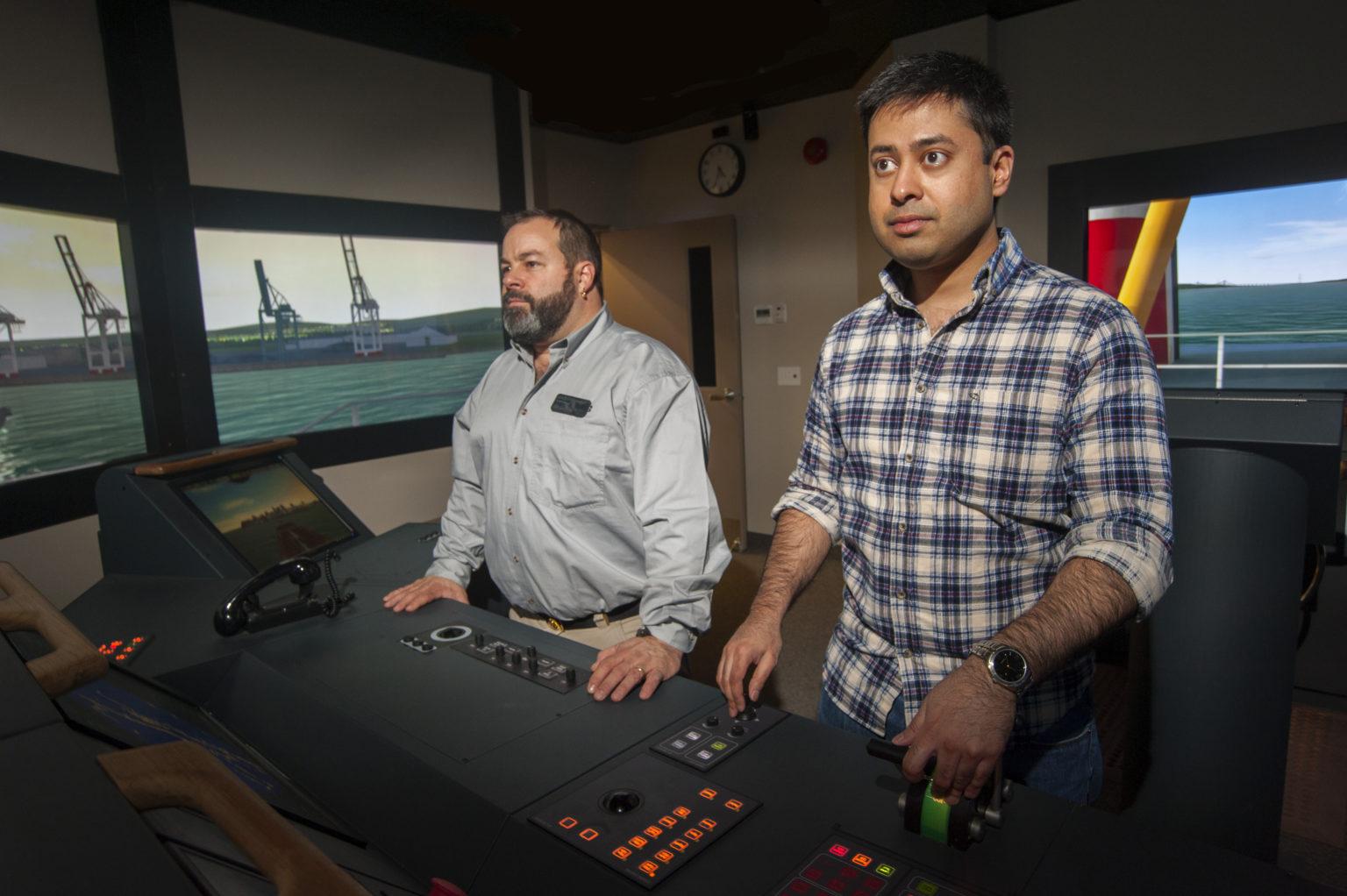
Photo by Doug Crawford. Capt. Seann O’Donoughue with former student Ian D’Mello, chief mate with Canada Steamship Lines in the marine simulator.
Equipment mimics behaviour of a vessel in realistic environments, allowing students to navigate confidently in any setting, and without risk.
The Great Lakes-St. Lawrence waterway, being the longest inland deep-draft navigation system in the world, is an incredibly advantageous resource to the marine shipping industry, however it does not come without its challenges. Narrow canals, strong currents, high traffic volumes in some areas, winds and other intense weather conditions are just some of many factors that can contribute to difficult inland marine shipping in the waterway, only fit for highly experienced and certified captains and ship handlers.
Latest technology at Georgian College’s Centre for Marine Training and Research (CMTR) allows marine students to learn, practice and perfect the skills necessary to become a certified marine captain, all through virtual marine simulator technology. The highly advanced virtual marine simulation equipment mimics behaviour of a vessel in realistic maritime environments, allowing students to navigate confidently in any setting, and without risk.
Capt. Seann O’Donoughue, a marine pilot with the Great Lakes Pilotage Authority and marine simulation instructor at Georgian College, says there are many advantages to marine simulation technology, one of which being the time efficiency in comparison to real life experience, “With the simulator, we are able to go up and down the St. Lawrence River 5-6 times per day, whereas on a standard cargo ship in real life, you would only be running that route once every 3 weeks.”
The marine simulation training program at Georgian College consists of dozens of different courses, some of which include radio communication, radar navigation, bridge resource management, river pilotage training, ice and hazardous environment navigation, ship handling and survival at sea.
Simulation technology has not always been this advanced, giving today’s youth a huge advantage in quality of training and preparation before working on a vessel for the first time.
Capt. O’Donoughue has observed these advancements in simulation technology over the years, “The current style of training is far more superior than what was available 20 years ago. The technology has improved the amount of knowledge and learning criteria available. It is absolutely amazing how far things have come in the last few decades.”
“If a student is going to a port in the simulator, we can pair the ship with very strong winds and rough weather, to find out what the maximum limit and cut off point is. It is much better to make this discovery through the simulator, rather than in real life when you aren’t sure what to expect.”
Virtual marine simulator training is unique to each student and is adjusted according to each individual’s strengths and weaknesses in the program. The simulator is entirely customizable, allowing instructors like Capt. O’Donoughue to select exact weather conditions, currents, traffic, difficulty levels, etc. of each exercise to ensure that students are trained for each and every possible outcome, “With the amount of detail we have in the simulator – we are able to simulate different scenarios – from zero visibility in heavy fog to very high precision piloting and navigation in tight channels.” describes Capt. O’Donoughue, “We can practice as much as we want with different levels of difficulty, for a brand new student we will use simple levels with nice weather conditions, and with more advanced training we will throw in a snowstorm or fog when they have less visibility, for more of a challenge.”
Increased amount of practice and confidence working under harsh conditions reduces mistakes that can occur later on in the workplace, ultimately increasing safety levels for all parties involved. “Students are able to repeatedly go through the motions of handling emergency protocols. We simulate emergency situations such as steering failures, grounding or fires on board. We go through all of these scenarios while in the simulators, which are especially important for leadership training,” emphasizes Capt. O’Donoughue.